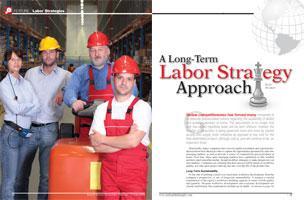
 Global competitiveness has forced many companies to re-evaluate preconceived notions regarding the availability of skilled and qualified workers at home. The assumption is no longer that only low-skilled repetitive tasks will be sent offshore. Instead, the location of production is being governed more and more by market access and supply chain networks as opposed to low cost for the final assembled product; although cost is, and will continue to be, an important driver.
Global competitiveness has forced many companies to re-evaluate preconceived notions regarding the availability of skilled and qualified workers at home. The assumption is no longer that only low-skilled repetitive tasks will be sent offshore. Instead, the location of production is being governed more and more by market access and supply chain networks as opposed to low cost for the final assembled product; although cost is, and will continue to be, an important driver.
Historically, major companies have moved capital investment and exported production know-how abroad in order to capture the opportunities presented by sales into emerging markets, as well as provide a source of competitively-priced products at home. Over time, these same emerging markets have capitalized on this windfall and have used somewhat similar, though modified, strategies to make inroads into our own markets. Companies are realizing that their success will be based on workforce quality, not only upon project start-up, but also over the life of the product line.
Long-Term Sustainability
At the risk of utilizing a much over-used term, workforce development, from the company’s perspective, is one of long-term sustainability. It requires a careful examination of the region’s workforce building capacity in terms of both quality and quantity. Because workforce development and economic development are closely intertwined, this examination includes an in-depth understanding of the four-legged stool of economic development: recruitment, retention, expansion and entrepreneurship.
Companies need to understand the region’s support network that promotes and supports all four “legs” in equal measure according to the characteristics of a particular location – as well as the current needs of the company. Just as it is singular and misguided thinking to expect only one leg to support the economic development stool, this is the same flawed logic that expects workforce development to be one dimensional.
Companies change over time, as do communities and regions. Relying on only one program or philosophy will result in a stool that falls very quickly. The company that embraces a strategy that selects (or remains in) a location where workforce development is a continuous circle of activities (which includes educational infrastructure and business collaboration tied together with policies that are both reactive and proactive) will provide a better chance for workforce stability.
Evaluating the Labor Situation
For a company considering a new location, taking a three-tiered approach to evaluating the labor situation is important. First, examine secondary source data, typically from the U.S. government (Bureau of Labor Statistics, Census Bureau, etc.). This allows for some level of “apples-to-apples” comparison since the source and methodology behind the data are the same.
Second, examine local secondary sources – an example would be local wage surveys. This provides more focused and timely data for a specific location.
Finally, do primary research – on-the-ground interviews with local employers and employment agencies.
 Only after completing all three levels of research and analysis can you be comfortable with final assessments and comparisons of labor markets for a particular project. Using this approach, a company will have a reasonable assessment of current workforce availability, existing skills, trainability (in the absence of needed skills), and the extent to which the local and state resources can be utilized to assist in workforce development.
Only after completing all three levels of research and analysis can you be comfortable with final assessments and comparisons of labor markets for a particular project. Using this approach, a company will have a reasonable assessment of current workforce availability, existing skills, trainability (in the absence of needed skills), and the extent to which the local and state resources can be utilized to assist in workforce development.
Of course an analysis for a new location as described above is needs driven, where labor quantity and quality is benchmarked and then compared against some standard that includes the legal framework surrounding labor issues, productivity, attitude and skills.
The overall economics of a particular location influenced by such factors as logistics, market access and utility costs may justify a location where the ideal labor situation is sub-optimal from an experience and skills standpoint. In this case, properly assessing the trainability of the workforce, as well as the educational infrastructure in place, is extremely important to quickly and effectively mitigate this shortcoming.
Increasing Employment
As a company grows and becomes successful, there will eventually be choices of where to deploy additional capital resources, and as a consequence, increase employment.
Expansion at an existing facility is many times only an alternative, not a foregone conclusion. The existing location should be reevaluated and clearly demonstrated as a location that can provide a competitive advantage not only for present needs, but also for future needs as well.
Reassessing the labor situation at an existing location where an expansion may occur is very important because, quite simply, things change over time. The reassessment includes the previously discussed three-tiered approach, as well as a mapping of the workforce-building capabilities and capacity. The mapping includes a full assessment of the education structure fromK-12 to the post-graduate program.
A common mistake is to only examine various ratings such as ACT scores, SAT scores, and graduation rates for high school, as well as accreditation or achievement rankings of local colleges and universities, and assume this is a good proxy for workforce-building capacity. These measures are relatively good indicators of the educational system performance as it relates to college preparation, but it does not get at the technical training capabilities, or the system that prepares students for this career path. The fact is not everyone is destined to go to college. The shortage of skilled workers is, and has been, an alarming concern.
Assessing Workforce-Building Capacity
So how does one assess the workforce-building capacity of a region? Generally speaking, the following categories should be examined to make a qualitative judgment about a region’s workforce development:
Legislation and Policy
Funding and Resources
Recruitment and Retention
Support - Infrastructure
Incentives
There is a general agreement that K-12 educational quality is the cornerstone of workforce development. Examination of the existing legislation in place to either improve or sustain levels of achievement for students is an important indicator of priorities regarding economic development.
Legislation, of course, is a reflection of policy, and policy is action predicated on recognition of need. Policy and legislation cannot change the historical precedents that have resulted in poor performance in educational achievement; however, it can provide a framework for change that is proactive and forward thinking. Fundamentally, recognition that K-12 education feeds not only institutions of higher learning, but also career paths into many other occupations and trades, is very important. Policies that support the integration of all education institutions at every level, and that promote the K-12 system as the primary feeder into both the university system and the technical/trades system, is desirable.
Learn-to-work programs that provide an early opportunity for young middle- and high-school students to be exposed to, possibly even co-op with, local businesses is an example of one such program. A good indication that all levels are not aligned, or responsive to workforce-capacity building, is a lack of these types of initiatives. For instance, is “economic development” part of the mission statement of local colleges and universities? This speaks volumes to the level of cooperation that exists in an area.
Organizations that actively solicit input from business and industry and then develop curriculum and programs that address future workforce needs is another example. While this is important from companies considering a location for a plant startup, it is critically important for companies that are facing stiff competition in the marketplace. This activity affects both retention and expansions.
An examination of the technical school and community college curriculum compared to the predominant business and industry in the region will quickly demonstrate whether synergies exist or not. A distinction should be made between the ability to quickly react to economic development recruitment/retention/expansion opportunities compared to workforce-building.
 The former, while important, is opportunistic and reactive. Training under these circumstances is very company-specific and is an important capability to assess. Questions to ask when considering rapid training programs should include response time, quality, effectiveness, experience, cost avoidance and competency of trainee output.
The former, while important, is opportunistic and reactive. Training under these circumstances is very company-specific and is an important capability to assess. Questions to ask when considering rapid training programs should include response time, quality, effectiveness, experience, cost avoidance and competency of trainee output.
In contrast, the latter is more strategic and holistic. Workforce-building programs anticipate business and industry needs and create opportunity for employment through education and training. However, training in a region sometimes occurs where employment for that particular skill does not take place and is exported to a region where demand exists. Myopic thinking assumes this does not serve the needs of the region, when in reality it creates a pull that will eventually draw business and industry to the region – particularly if the program is a center of excellence when compared to its peers.
The delivery mechanism of education and training is as important as the content of the knowledge conveyed. The number of technical schools or community colleges is one indication of the availability of education to both citizens and industry in the region. However, outreach programs that exist at extension locations are significant as well. Extension programs should be an appropriate mix of person-to-person teaching and learning experiences, as well as virtual learning opportunities via telecommunications or self-directed internet programs. In essence, the opportunity to learn should be available to anyone regardless of where they are located or their economic situation that brings up another very important workforce-building characteristic.
In some regions, there is a pronounced disconnect between local, state and federal programs. While some of the requirements of various federal programs can become onerous and time consuming, when time is of the essence, this is not a good reason to dismiss the importance of available funding that can be used for other purposes. An important characteristic to look for in a region is the extent to which local, state and federal programs are integrated and non-overlapping with one leveraged as much as possible to enhance the other.
No workforce-building program is effective if there are no incentives available to promote and encourage the use of education and training. Incentives should be multi-faceted with quality in execution and delivery as the primary deliverable to both the community and business/industry.
In our opinion, this is the most powerful incentive available. For the company this means productivity, efficiency and quality; for the individual, it means employment. In both cases, education and training is not cheap and the cost is either time and resources or simply money. Without debating the pros and cons of incentives, the fact remains that in the absence of the necessary skills locally that could be available elsewhere, funding is not only expected, but it is required to create a level of parity. Investigating the level of funding, its source, and the level of continued commitment to education and training is essential. If the skills are not there, and neither is the funding, then it is time to move on.
Developing a Strategy for Workforce Development
Developing a strategy for workforce development is one of the most important elements that our clients are facing. Increasingly, they are looking beyond “crisis-driven” types of training that only address immediate needs and paying closer attention to the entire spectrum of workforce development and training that includes the entire educational system. Those that are fully aligned, coordinated, and business driven with a mission to deliver according to future needs, as opposed to constantly reacting to current ills, will be better positioned to help companies succeed. Competition in the marketplace is demanding that education fulfills the academic needs of higher education while at the same time making education and opportunity available to everyone at every level.

